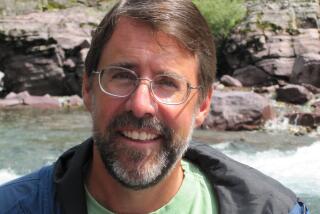Women on Road to Sobriety Aren’t on Easy Street Yet
- Share via
Who better to help a bunch of drunks than a bunch of ex-drunks?
That was Honey Thames’ thinking when she dreamed up Yellowstone, a 10-day detoxification home for women with alcohol problems.
It soon celebrates its first anniversary on East Bay Street in Costa Mesa, and is becoming known by police and judges as a better place than jail to take some women picked up for alcohol offenses.
It’s had its failures, and both the police and nearby residents say it isn’t always a perfect neighbor. But for many women, it’s at least a start.
“Our problem is, we don’t have enough places like Yellowstone,” said Costa Mesa police Lt. Ron Smith.
Thames, 56, a literature professor at Golden West College in Huntington Beach, is a recovering alcoholic who hit bottom in the 1980s and bounced back through help from other alcoholics. She’s become a helping hand herself.
The idea for the detox house, she said, came when she realized that sleeping five women in her living room to help them dry out was becoming a regular thing. Too many of them just had nowhere else to go.
“We’d set up the VCR and play four movies in a row; detox was staying sober through the fourth movie,” she says now with a chuckle.
About 18 months ago, Thames first approached some of her fellow recovering alcoholics about a women’s detox house. Several jumped at the chance to help. In November 1997, they set up a center at a small house on Costa Mesa’s Yellowstone Street (hence the name) but quickly outgrew it. Through recovery contacts, Thames learned of a woman in Dallas who owned the large, two-story Bay Street house and offered to lease it to them until they could buy it.
The first day of renovation last spring, 50 volunteers showed up, both men and women. Like Thames, all were ex-drunks--a term they use affectionately--who found the work more than therapeutic.
“We wanted to help these women. But believe me, we needed it for ourselves,” said Maryel McKinley, one of the original founders. “Yellowstone kept us from drinking too.”
It’s licensed for six detox beds, but those who run it hate turning anyone away, for either alcohol or drugs. It’s had overflow days, where volunteers have had to give up their own beds there.
Yellowstone helps women such as Penni Lee, who had been living in a camper in the back of a store when the detox house took her in.
“I lived in a park before that,” Lee said. “I had no food; my only clothes were a halter top I was wearing.”
Lee lasted beyond the minimum 10 days--mainly for the free meals, she admits. She now lives at a long-term recovery facility here in Orange County. She pays her rent there working as a dog groomer, but returns to Yellowstone several times a week to volunteer.
Not that Yellowstone works for everyone. Many can’t make the 10-day minimum.
“When you are obsessed with alcohol or drugs, it’s a real struggle to stay away from it for 10 days,” Thames said.
The night before I visited Yellowstone, an 18-year-old drug addict decided to skip after less than a week. House manager Marilynn Stewart-Baugh got hold of some half-dozen volunteers who hurried over to talk the young woman into staying.
The next day, when Penni Lee was leading a group session, the 18-year-old spoke about her problems for the first time.
“Before coming to Yellowstone, I didn’t think I could ever love myself again,” Lee said. “And I’d never tried to help anyone else. That’s the ticket for me staying clean, helping others.”
Lee was the only one who would give me her full name. But among others I talked with there was Veronica, on parole from prison for a string of burglaries she committed to feed a heroin habit. A former Yellowstone resident, she takes the bus every day from Santa Ana, and readily confesses that she volunteers mainly to help herself.
“In my neighborhood, drugs are so prevalent I can’t hang out there,” she said. “Coming here is the only way I can make it.”
Not all get a chance to escape jail by going to detox. Superior Court Judge Gregory Lewis says some alcoholic women who come through his court can’t handle such a program. But he did recently take a chance on a two-time jail inmate by sending her to Yellowstone. She’s working now and has made it to long-term recovery.
“It’s nice to see a happy ending,” Lewis said. “But many have wanted detox, failed, came back to court, then wanted, failed, and came back again.”
Yellowstone is making inroads with other judges too. It’s received small donations from Borders Books and Music nearby, and recently got its first grant, $16,000 from county government. They have also been sent referrals via the Orange County Probation Department.
“We have passed from begging to planning,” Thames said.
Part of the plan is to ask the city of Costa Mesa to let the facility grow to 14 beds. But that might not be so easy to get. Some of the neighbors aren’t happy about it.
I did find one neighbor, Kerry Mullins, who praised Yellowstone for what it’s accomplishing. But several others I talked with are not as pleased. They’re passing around a petition to oppose the bed increase.
While they acknowledge Yellowstone is a worthwhile endeavor, they’re upset about inadequate parking, especially on some Sundays, when Yellowstone holds large group sessions for its volunteers. Neighbors say they take up too much of the available street parking. Some complain they’re also too noisy.
“This is a residential neighborhood,” said Anita Knoblaugh, who lives two doors away. “We just don’t want to see them [Yellowstone] get any bigger.”
But the parking is public street parking, and most said the noise is only bad on Sundays. These dilemmas seem small trade-offs compared to the good coming out of the house.
Maybe it would help if some of the neighbors would meet Penni Lee.
Jerry Hicks’ column appears Monday and Thursday. Readers may reach Hicks by calling (714) 564-1049 or e-mail to [email protected]
More to Read
Sign up for Essential California
The most important California stories and recommendations in your inbox every morning.
You may occasionally receive promotional content from the Los Angeles Times.










